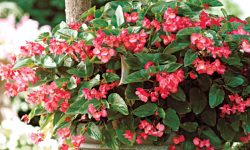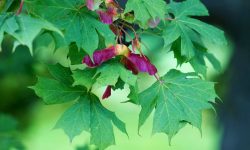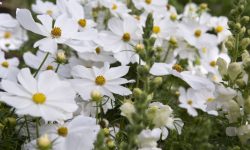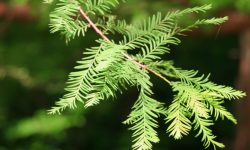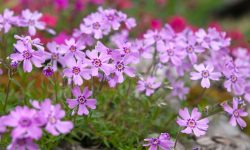Any garden setting is made more calm and alluring by the addition of blue perennial flowers. These blossoms give outdoor settings a feeling of elegance and tranquility with their calming colors that are reminiscent of the sky and sea.
Blue perennial flowers, with their delicate petals to their sturdy clusters, captivate garden aficionados with their beauty and adaptability.
Different Types of Blue Perennial Flowers
Blue Delphiniums
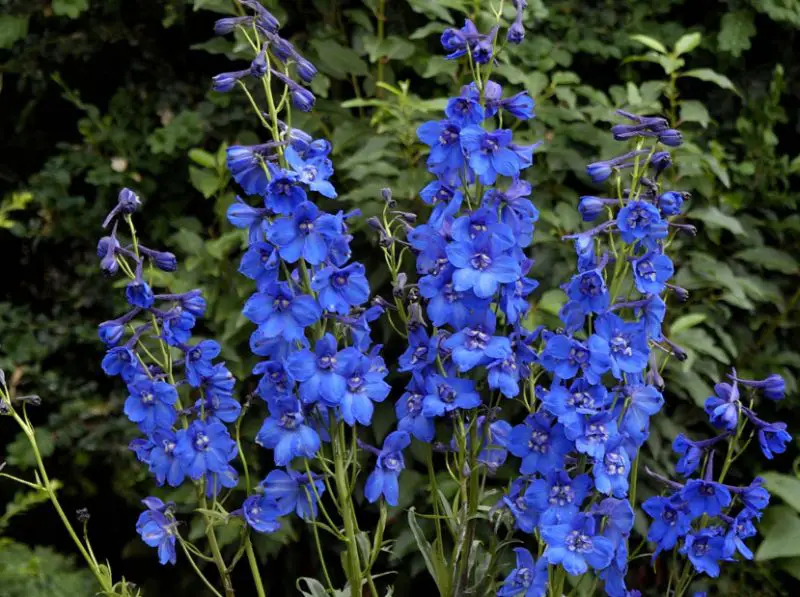
Blue delphiniums, scientifically known as Delphinium grandiflorum, are prized for their stunning spikes of colorful summer blooms, making them a staple in wildflower bouquets. These perennials boast charming shades, particularly in blue hues.
Despite their delicate appearance, blue delphiniums can grow quite tall, requiring additional support to reach their full potential.
Thriving in full sun yet tolerant of partial shade, they prefer moist, well-draining soil. With proper care, they grace gardens with their vibrant presence, attracting admirers and pollinators alike with their elegant stature and captivating blue blossoms, adding a touch of enchantment to any landscape.
Blue False Indigo
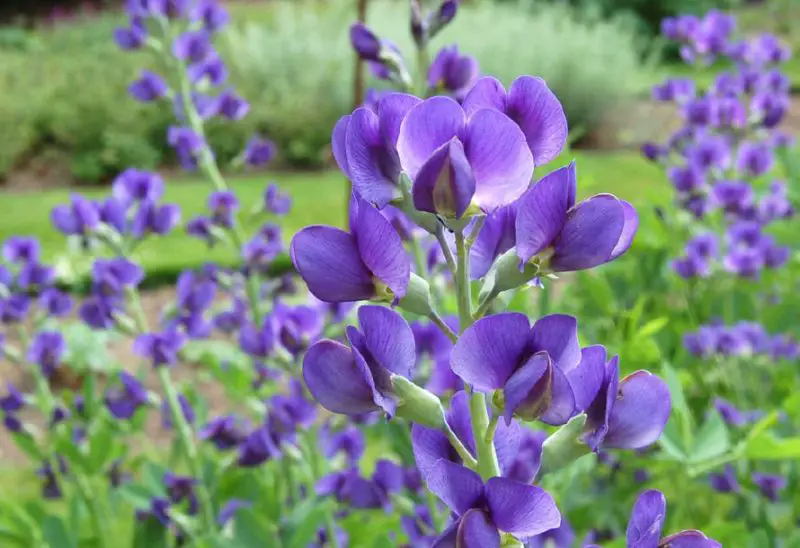
Blue false indigo, also known as Baptisia australis, is characterized by robust, tall stems covered in gray-green foliage and beautiful indigo-blue racemes that bloom from April to June. With their five-foot height, they make striking displays, especially when tucked up against fences or mixed in with other plants.
They thrive in full sun or light shade, however full shade need extra support. Adaptable to a wide range of situations, blue fake indigos are remarkably durable, withstanding drought and poor soil conditions.
Plant seeds in early autumn for propagation; although they may take a while to flower, patience is needed. It is still a valued addition to any garden because of its timeless beauty and versatility, even with the wait.
The Blue Star
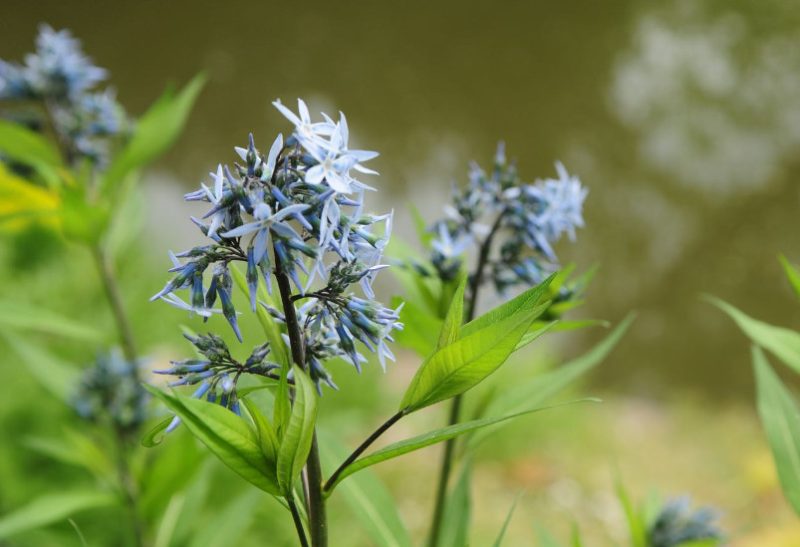
The Blue Star, scientifically known as Amsonia tabernaemontana, graces gardens with its delicate, pale blue star-shaped flowers. These herbaceous perennials are a charming addition to any landscape, thriving in various environments.
Adaptable to different soil types, Blue Stars prefer average, well-drained soil but can tolerate dry conditions. While they can flourish in partial shade, they truly thrive under full sun, requiring minimal maintenance like pruning or staking, making them ideal for novice gardeners.
Usually appearing in the second year of the plant’s life, these blooms bloom in late spring or early summer, adding to the charm of any garden setting and rewarding patience with their ethereal beauty.
Delphinium
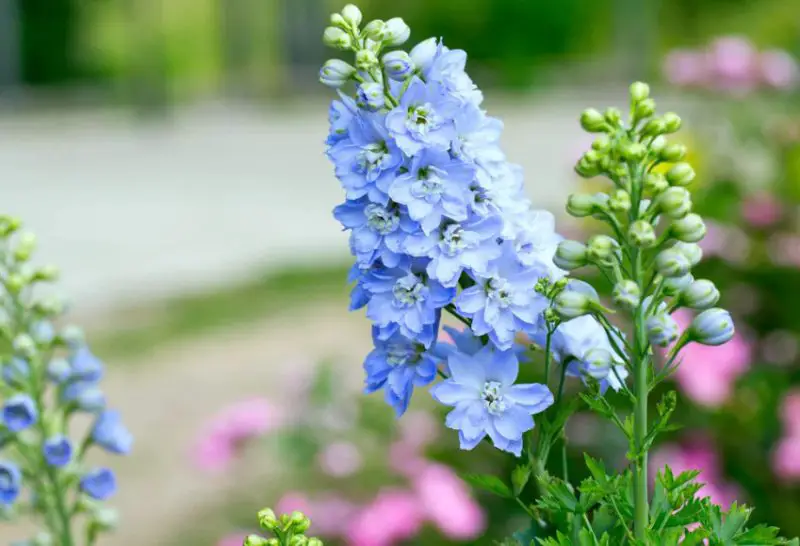
Delphinium, as it is known scientifically, is a must-have for lovers of flowers, prized for its vivid colors, which include the traditional blue. It stands out in gardens, reaching up to 6 feet in height and 3 feet in width.
Throughout June and July, delphiniums, which thrive in direct sunlight, produce breathtaking blooms. They favor fertile, alkaline soil that drains properly and is devoid of pesticides. The beds are kept sufficiently moist with compost, and mulching promotes the best possible development.
The delphinium, with its unique beauty and soil requirements, rewards gardeners with an amazing show of color. This makes them a highly desirable option for anybody looking to add more charm and attraction to their garden.
Empire Blue Butterfly Bush
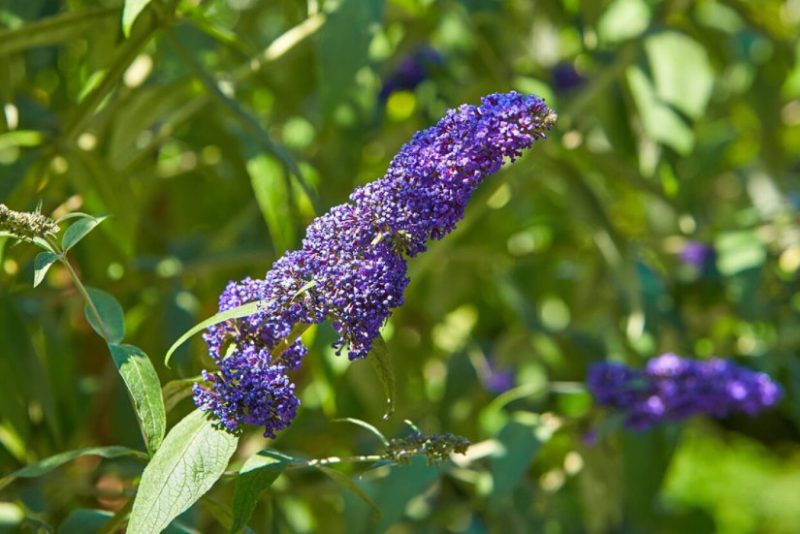
Known by its scientific name, Buddleja davidii ‘Empire Blue,’ the Empire Blue Butterfly Bush is a wonderful addition to any garden. It has lance-shaped leaves and branches covered in tiny blue perennial blooms. Because of its potent scent, it attracts hummingbirds and butterflies.
This shrub, which grows well in well-drained soil and full sun, blooms nonstop when planted in a location that gets enough sunlight.
With its charming blooms and ability to attract pollinators, the Empire Blue Butterfly Bush adds beauty and life to any garden, creating a serene and vibrant space for both humans and wildlife to enjoy.
Forget-Me-Nots
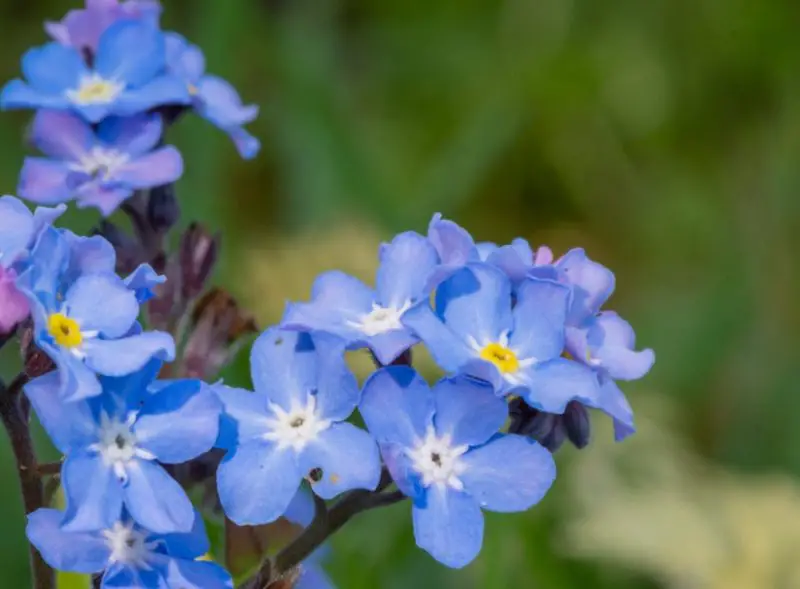
Myosotis arvensis, the scientific name for Forget-Me-Nots, is a beautiful ground cover with glossy dark green foliage and pretty blue or white flowers that bloom in early spring. Their exquisite flowers, which have five petals with yellow centers, lend beauty to any setting.
Though they can withstand full light, these low-maintenance plants grow best in moist, shady spots, which makes them useful complements to gardens. Forget-Me-Nots’ easy elegance and adaptability mean that they require little care, so gardeners can enjoy their captivating blossoms without worrying about ongoing maintenance.
Himalayan Blue Poppy
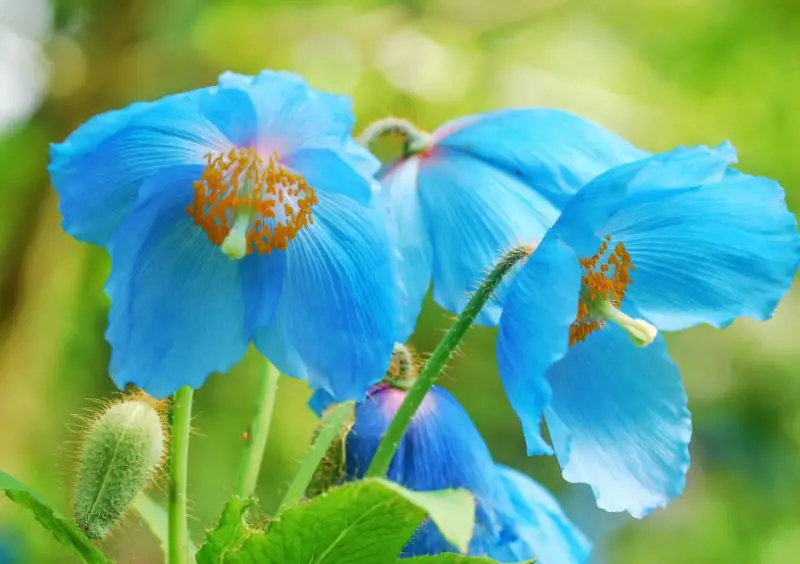
Meconopsis betonicifolia, the scientific name for the Himalayan Blue Poppy, is well known for its exquisite beauty. These gorgeous blue perennials can be a little picky about their needs, but they do well in gardens with little shade.
They need well-drained, slightly acidic soil that isn’t too damp for optimum growth. Humus supplements can help them reach their full potential for growth. Furthermore, they are not suited for hot locations because they prefer milder summer temperatures.
If you’re looking to create a lovely, shaded sanctuary filled with these enchanting blossoms, gardening enthusiasts should not underestimate the wonderful attractiveness of the Himalayan Blue Poppy, despite its somewhat demanding nature.
Hyacinth
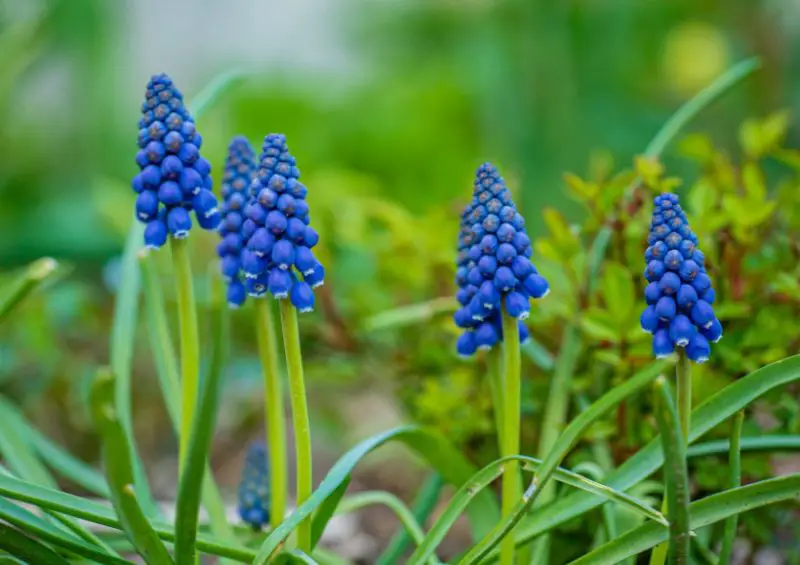
Hyacinths, or Hyacinthus scientificus, are prized for their exquisite blooms, especially those with blue tones. These lovely creatures do, however, have particular requirements for healthy growth.
Hyacinths need considerable attention to grow; they thrive in full sun and in fertile, well-drained soil that is free of pesticides. In mid-spring, they bloom for a short but spectacular two to three weeks, rewarding gardeners with their captivating scent and vivid hues.
Plant your hyacinths in the autumn to enjoy their full blossoms in the spring, for the most beautiful display of the plant. These treasured flowers will adorn your yard with their alluring presence and delightful scent with the right maintenance and care.
Hydrangea
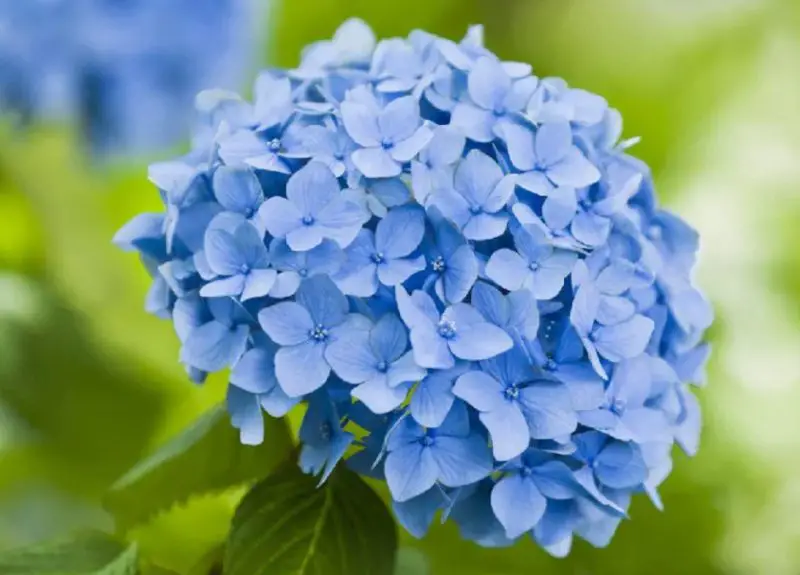
With a multitude of colors to complement your landscape, hydrangea, also known scientifically as Hydrangea macrophylla, is a magnificent addition to any garden paradise. The tints of the blue hydrangea change according to the alkalinity of the soil, giving its blossoms depth and charm.
Hydrangeas should not be exposed to hot, direct afternoon light for best growth; instead, they should be let to enjoy morning sunshine. With the right care, hydrangeas may withstand harsh winters and bloom again every year, providing a constant display of their alluring beauty in your yard. They can be planted as early as spring and can reach late summer.
Iris

Irises are some of the simplest blue perennials to grow, lending elegance and a sense of summertime freshness to any garden. They come in more than 300 species globally, offer a wide variety of colors, and do well in a variety of sun and soil conditions.
You can enjoy flowers from early spring to summer by combining various species of irises, which will improve the appearance of your garden. Irises come in a range of sizes and heights, from delicate dwarfs to towering giants, which makes them ideal for designing a well-planned landscape that blooms with their alluring beauty all year.
Leather Flower
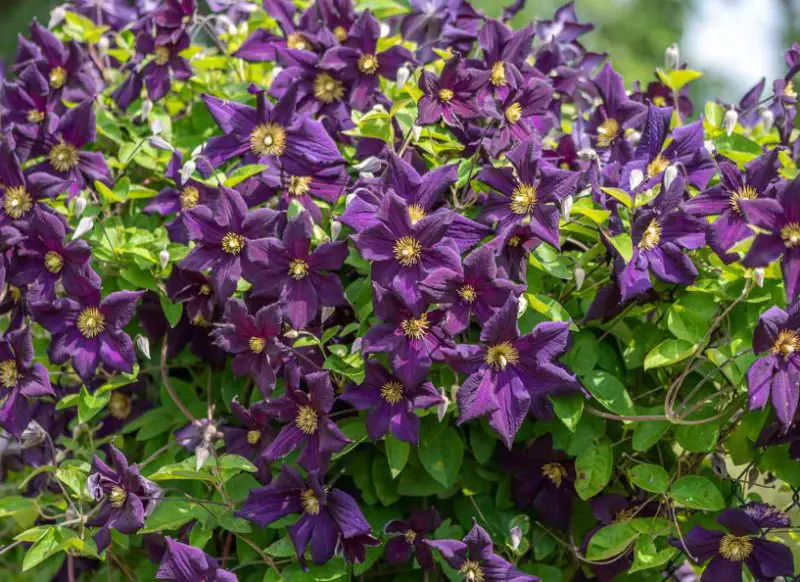
Clematis, or leather flowers, as they are officially called, is regarded as one of the best perennial vines for creating a veritable garden oasis. Their enormous, beautiful blooms come in the summer, and their thick, smaller petals appear in the fall, giving the appearance of a verdant forest.
Regardless of the season they bloom, these vines add a dramatic touch to walls, fences, and garden accents with their lovely climbing habit.
Though it comes in a range of hues, the blue variant is particularly alluring. Leather flowers, which lend a touch of elegance and vitality to any outdoor environment, bloom constantly throughout the season when they thrive in well-drained soil and plenty of sunlight.
Lily of the Nile
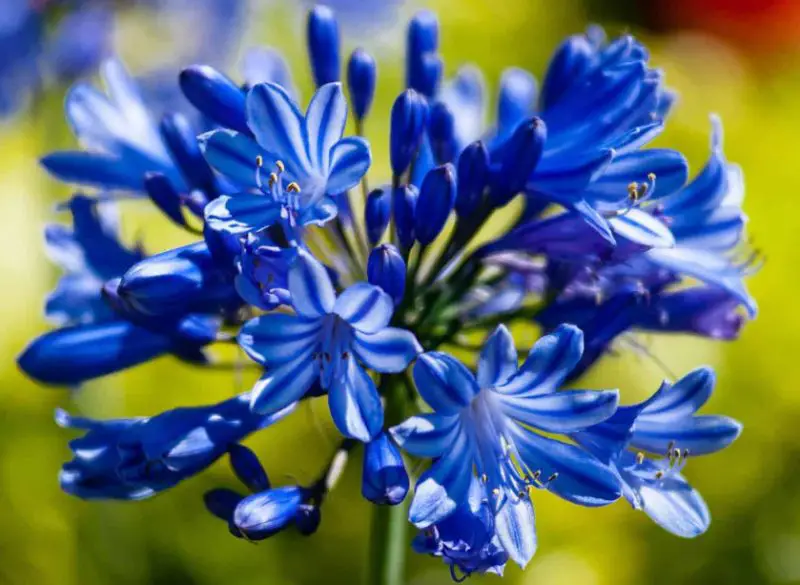
Agapanthus africanus, the technical name for the lily of the Nile, enchants with its multitude of blue hues. These sensitive perennials need at least eight hours of sun exposure per day to thrive. But they suffer in intense heat, thus in hot climates, you have to put them in shady spots.
They grow best in rich, fertile, organic soils that range in pH from acidic to alkaline. During the growth season, they could need regular irrigation. But watering can stop after the leaves turn yellow. The Nile lily, which blooms from June to July, adorns gardens with its breathtaking beauty and lends a touch of refinement to any setting.
Lungwort
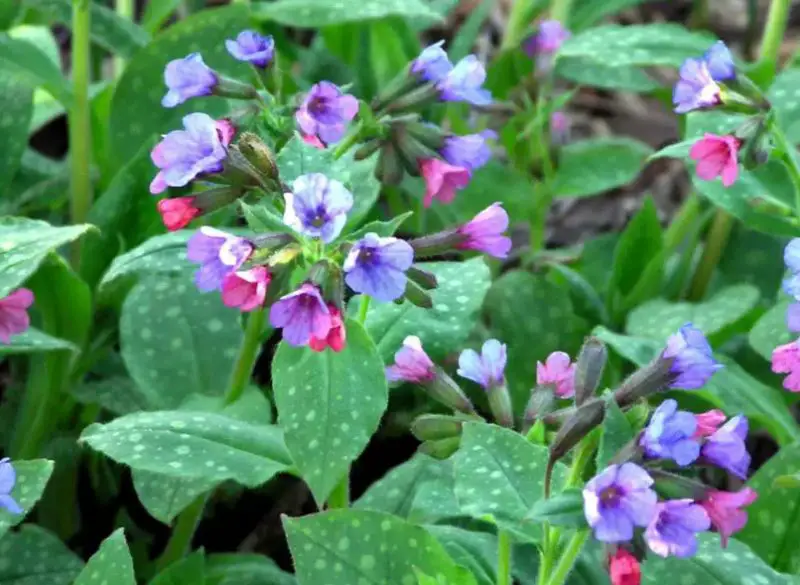
As winter fades, lungwort, formally known as Pulmonaria officinalis, brightens gardens with its lovely blue blossoms. Measuring only 6 to 12 inches in height and up to 18 inches in width, this low-growing perennial is adaptable enough to grow in a variety of settings.
Lungwort is a plant that prefers partial shade, grows well in moist, fertile soil, and needs frequent watering to stay healthy. Though periodically challenged by slugs and mildew, it is resistant to illnesses and pests despite its small stature. When given the right care and attention, lungwort enhances the beauty and charm of gardens and provides a wonderful pop of blue to the scene as winter comes to a close.
Lupine
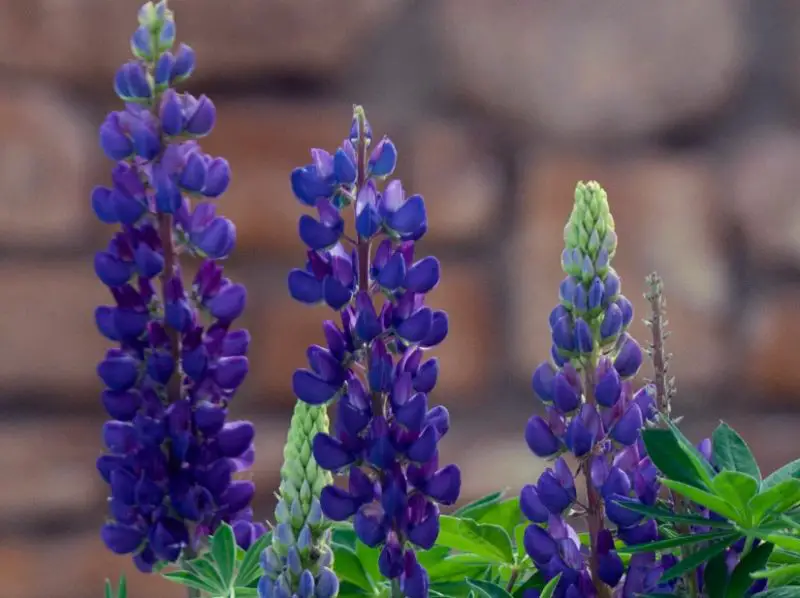
Lupines, or Lupinus as they are known technically, are beautiful blooms that come in a variety of colors. These towering plants have a maximum height of 4 feet and a maximum width of 1.5 feet.
Lupines need full sun exposure and soil that is rich, well-drained, and sufficiently moist for optimum development. Their flowering season lasts from spring to summer, offering a long-lasting, vibrant display.
A popular among gardeners looking to improve their outdoor areas, lupines are instantly recognized in gardens thanks to their vivid blossoms and towering stature. They also provide a dash of color and elegance to any landscape.
Perennial Geranium
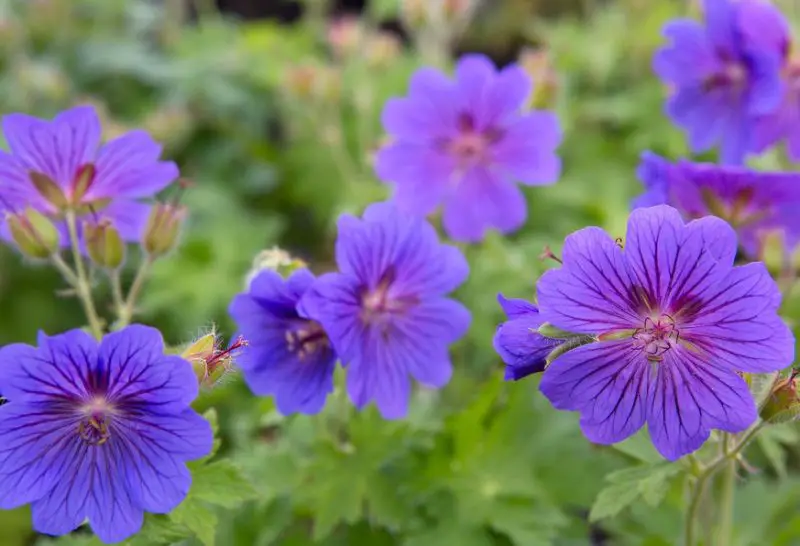
Geranium sylvaticum, or perennial geraniums, are a beautiful addition to any garden because of their colorful flowers and widely dispersed leaves. These towering plants produce an abundance of beautiful deep blue flowers that brighten gardens from June through the bitterly cold winter months.
Perennial geraniums can grow in full sun or light shade and do best in well-drained soils. Because they are resistant to slugs and aphids and need little care, they are a great option for low-maintenance gardens.
Perennial geraniums are a popular among gardeners looking to add vivid colors and graceful blooms to their outdoor areas because of their long-lasting beauty and ease of maintenance.
Periwinkle
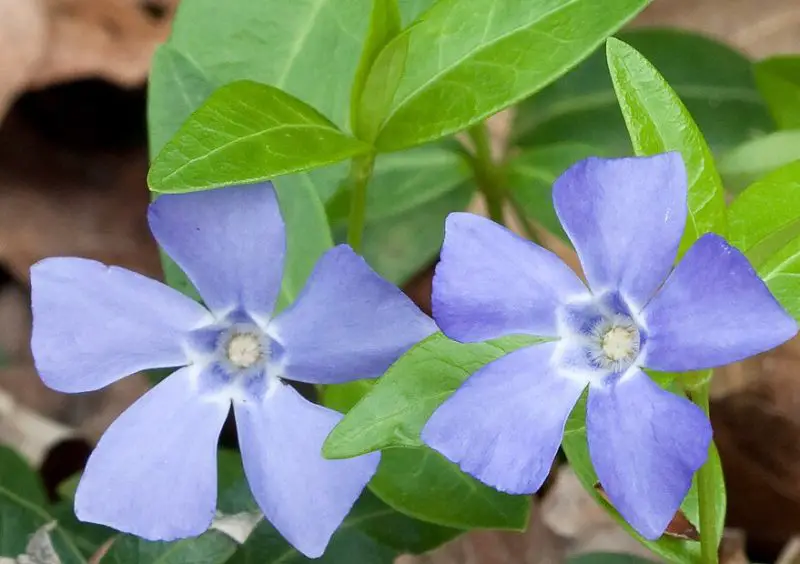
Scientifically known as Catharanthus roseus, periwinkle is a pretty shrub with flowers that are the color of the sea, sky blue, and they smell quite nice. Because of its small size, it is frequently used as ground cover. It blooms rapidly, giving taller plants a great starting point.
Periwinkle grows best in moderate shade, where it receives controlled sunlight to avoid scorching, although it also thrives in well-drained soil and medium sunlight.
It’s easy to grow and take care of because it can withstand dry circumstances and just needs a little watering. Gardeners who want to add colorful blossoms and a fragrant scent to their outdoor settings are drawn to periwinkle because of its long-lasting beauty and low maintenance requirements.
Pincushion Flowers
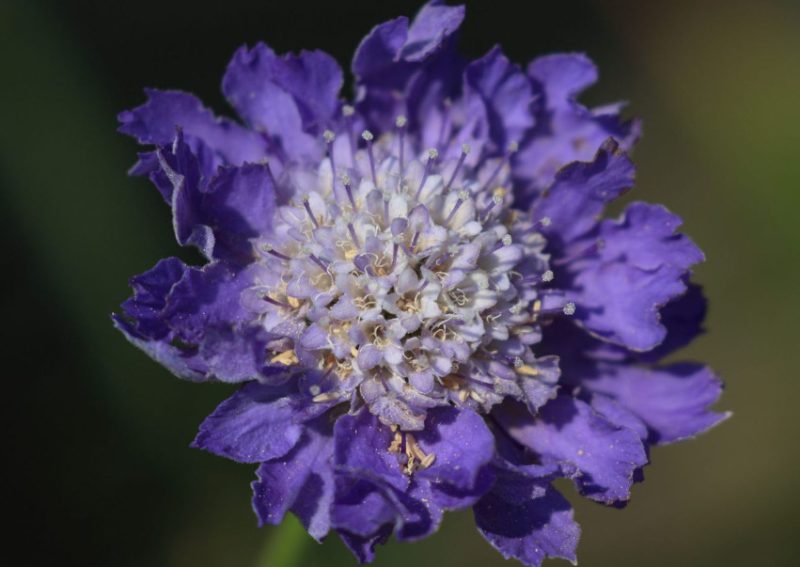
Scabiosa japonica, a vigorous perennial that produces clusters of blue blossoms from late spring through winter, is the scientific name for pincushion flowers. They offer a dramatic touch to any garden, growing up to 18 inches tall and spreading out to 15 inches wide.
Pincushion flowers, which thrive in full sun, yield their best blooms when exposed to direct sunshine; but, in warmer areas, they would like some shade.
They favor average pH, moderate moisture content, and well-drained soil. Pincushion flowers are drought-tolerant and can add seasonal appeal to gardens with regular maintenance, including the occasional watering during dry months.
Azure Aster
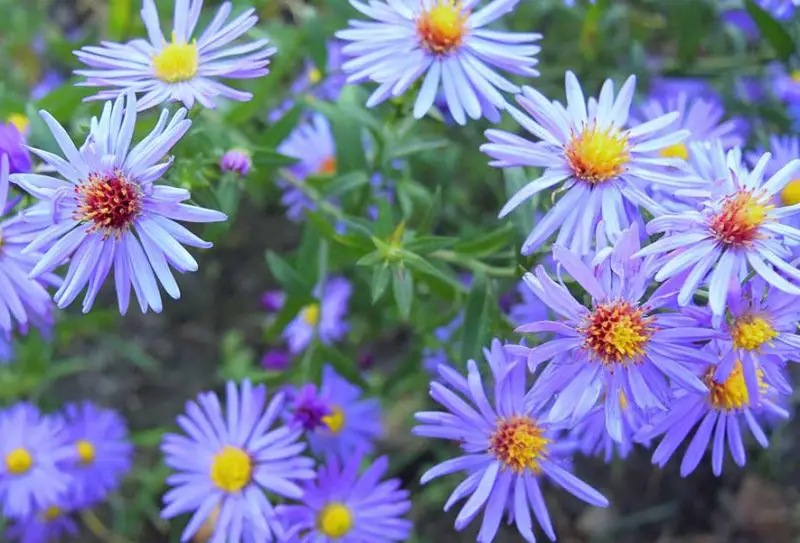
In the perennial garden, the Azure aster, or Symphyotrichum oolentangiense, is a symbol of beauty and tenacity. This rhizomatous perennial unfurls its leafy branches throughout the summer, preparing the ground for its striking blue flowers, which are the primary attraction from fall to early January.
It grows to a moderate height of 60 to 90 cm and a width of 45 to 60 cm. It is adaptable to USDA zones 3 through 9. For best flowering, it needs direct sunlight, but it can withstand a fair amount of shade.
The Azure aster may grow in a variety of soil types, from sandy to rocky, as long as it drains properly and has an acidity level between 5.5 and 7.5. It’s a low-maintenance yet eye-catching addition to any garden, with remarkable resistance to pests and diseases. However, it still benefits from proper air circulation to avoid frequent difficulties like powdery mildew.
Balloon Flower
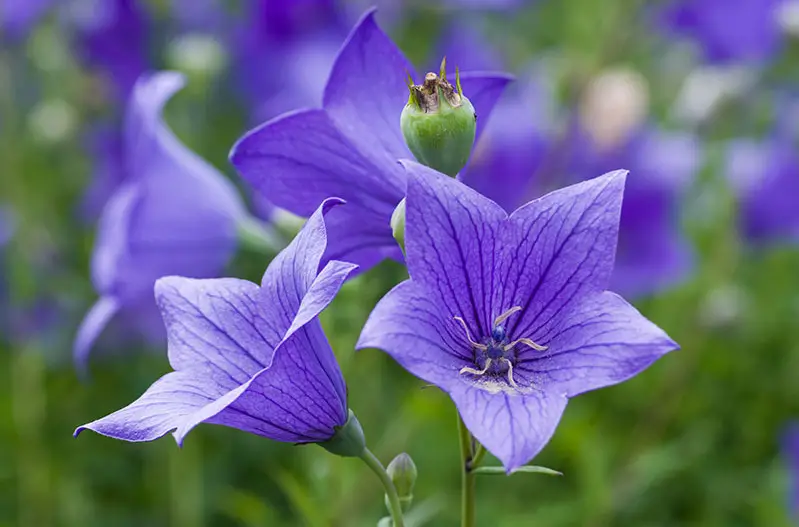
With their puffy, balloon-like buds that expand into star-shaped blooms, balloon flowers, or Platycodon grandiflorus, provide a fascinating display. Warm weather is essential for these flowers, therefore spring is the best time to grow them.
They grow best in loamy, well-drained soil and thrive in full sun, though they may also withstand some shade. Balloon flowers exhibit a constant display of vivid blooms throughout the summer, and they are also resistant to pests and illnesses.
Suitable for USDA zones 3 to 8, these hardy perennials need some support to keep their tall stature and will provide elegance to your garden year after year.
Bird-Bill Dayflower
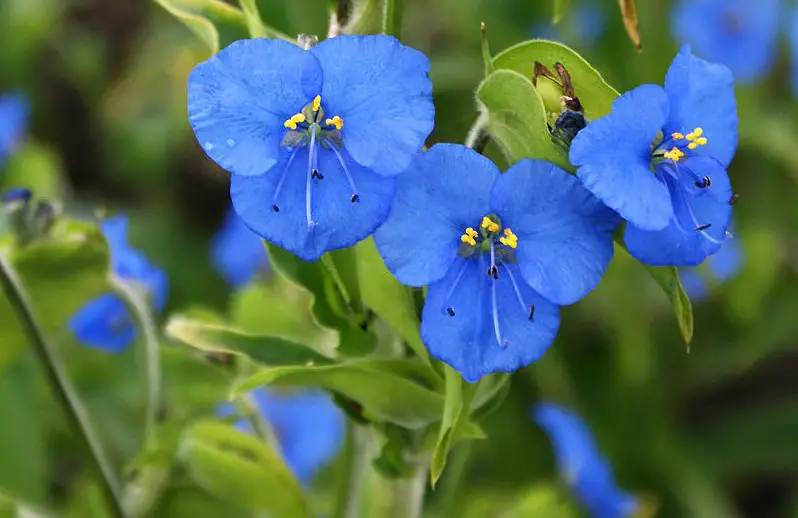
Commelina dianthifolia, sometimes known as bird-bill dayflowers, are eye-catching blue perennials with distinctive flowering habits. Every flower has three mouse-ear-like petals that open at sunrise and then wither around lunchtime.
These hardy plants, which bloom from summer into early October, are tolerant and may grow on rocky, damp, or even soggy soils. Even though they like full sun, bird-bill dayflowers can also thrive in some shade.
Ideally suited for USDA zones 6 to 9, these flowers are a dynamic addition to gardens, adding a splash of blue and intriguing daily transformation from dawn until noon.
Bluebell
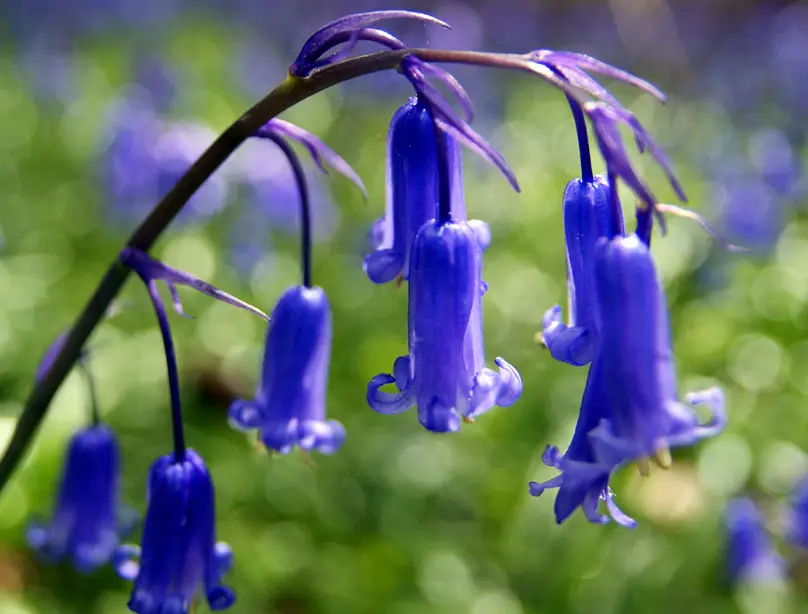
Bluebell flowers, also known as English bluebells or Hyacinthoides non-scripta, grace gardens with their picturesque bell-shaped blooms. Emitting a sweet yet potent fragrance, they enchant walkers in bluebell woods, attracting a myriad of pollinators like butterflies and birds.
Thriving in partial shade, these perennials prefer moist soil conditions, though they can tolerate full sunlight. Grown from bulbs resilient to frost and extreme temperatures, bluebells bloom from early to late spring, disappearing by midsummer.
Their enduring beauty and ability to flourish in shaded environments make them a delightful choice for gardeners seeking to create enchanting, wildlife-friendly spaces imbued with the ephemeral magic of springtime.

